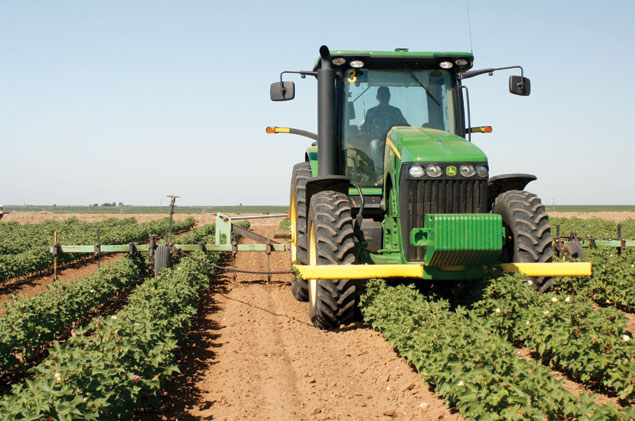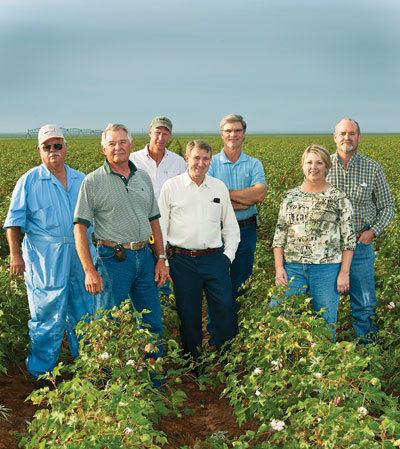In the summertime, James and Susan Wedel don’t travel far from their Muleshoe, Texas, home. With more than 4,000 acres of cotton and several other crops, six full-time employees and a crew of seasonal workers, the farming operation requires the Wedels’ attention virtually seven days a week.
The reason — they farm organically, trading chemical fertilizers, pesticides and herbicides for increased labor, management and equipment.

Photographed in late August, a field of organic cotton on Carl Pepper’s farm near O’Donnell, Texas, is cultivated for weed control. Hand-hoeing catches any weeds that the cultivator misses.
Photo by Janet Hunter
According to Wedel, who is president of the Texas Organic Cotton Marketing Cooperative (TOCMC) board and a director of Capital Farm Credit, farming without chemicals requires extreme dedication. “You have to be willing to put in intensive management from May to September. You can’t play golf, can’t go to ballgames and can’t go to the lake,” he says. “If you’ve failed as a manager on a conventional farm, you’re not going to make it farming organically.”
It was that strong focus on management that impressed AgTexas Farm Credit Services loan officers in 1996, when the TOCMC approached AgTexas about financing for the young cooperative.
“Most of the members were considered exceptional production and financial managers, therefore they could afford to take a little more risk,” says Rodney Keeton, AgTexas regional vice president of credit services.
Established in 1993, the Lubbock-based co-op’s 30 or so members had proved they could grow cotton without the benefit of chemicals. They had even secured markets for their crop. However, the cooperative needed interim financing, so that it could carry inventory until the crop was sold.
Financing the Co-op
“Originally, a lot of bankers didn’t want to look at organic farming,” says Carl Pepper, TOCMC vice president.
But AgTexas, which has financed Pepper’s organic cotton operation near O’Donnell since 1992, was an exception. The lender made a business loan to the TOCMC in 1996 and has continued to finance the cooperative since.
“These are exceptional folks with a great story. They did organic before it was popular!” says Mitchell Harris, AgTexas chief executive officer. “The co-op has brought great value to its committed stockholders.”
Currently, TOCMC has 41 members, of whom 27 are actively growing organic cotton. Together, they produce approximately 90 percent of the entire U.S. organic cotton crop.
“These are exceptional folks with a great story. They did organic before it was popular!”
— Mitchell Harris
The members’ production has fluctuated over the past 17 years, from a low of 3,140 bales in 1993 to an average of 9,512 bales annually from 2005 to 2009. With a record 11,000 acres of organic cotton planted last spring — of which 60 percent was dryland — the cooperative anticipates near-record production for 2010.
AgTexas’ financing has allowed the TOCMC to act as the merchant for the co-op’s members, holding their cotton until it is needed by spinning mills, primarily on the East Coast. When members deliver their crop to the gin, after the conventional ginning season, they put it into the government loan program for nine months. The co-op typically makes a progress payment to members in June or July and another payment in October. If the crop hasn’t sold by October, AgTexas funding is used to redeem unsold bales from the government program. In February, a final payment is made in the form of cash and co-op equity.
Organic Averages Over $1
Historically, Texas organic cotton prices have exceeded conventional cotton prices, with producers receiving an average of $1 per pound over the last five years. In addition, the premium for organic seed, compared to conventional seed, has netted growers an extra 15 to 20 cents per lint pound.
“There’s more risk and more stress involved,” says Wedel, “so I’ve got to be rewarded for the risk.”
The risk comes from both the marketing and production sides of the business. In 2007, for instance, demand for organic cotton was three times greater than supply. “We told the manufacturers it would take $1.50 a pound to get more growers. Then, in 2008, the economy cratered. They used up our inventory, but it took almost a year and we had to lower our price significantly,” TOCMC Manager Kelly Pepper explains.

The 2010 directors of the Texas Organic Cotton Marketing Cooperative are, left to right, Frank Evridge, Ron Goebel, Carl Pepper, James Wedel, Cliff Bingham, Darlene Vogler and Mark Wilkes. They have chosen to farm organically for two reasons — environmental stewardship and increased profit potential..
Artie Limmer
While organic cotton in other countries sells for slightly more than conventional cotton, Texas organic cotton producers have developed a strong reputation for quality, reliable service and trustworthy organic certification, and some companies are willing to pay a premium for U.S.-grown cotton. “Our USDA HVI classification system is a major advantage we have over the rest of the world,” says the TOCMC manager. In addition, the cooperative offers traceability, so each bale can be traced to the grower. “We are a higher-priced niche, within the world organic cotton niche,” Kelly Pepper says.
Organic cotton farming is even a niche within Texas and the nation. The crop is concentrated on the South Plains because of the region’s dry climate. Insect pressure is minimal here; night-time freezes in the late fall naturally defoliate cotton, which means growers can avoid chemical defoliants; and weeds are less of a problem than in wet climates.
Still, by shunning pesticides, organic cotton producers leave their crops vulnerable to disease outbreaks and insect infestations, and weed control remains their No. 1 management challenge.
A Tough Row to Hoe
“Whatever we don’t control mechanically, we have to hoe,” says Wedel. He budgets $150,000 a year for hoeing labor. “We’re doing a whole lot for the local economy, hiring local people,” he points out.
Mark Wilkes of Meadow hires several dozen seasonal workers, in addition to full-time employees, mainly to help with hoeing on the 3,000-plus acres of organic crops that he raises on farms scattered from Pecos to Earth, Texas. “I think my full-time employees are really vested in the farm. They’ve bought into it. They’re as proud of it as I am,” he says.
Adds Susan Wedel: “They also appreciate not having to handle chemicals.”
Organic cotton production may require extra management, but it definitely has its rewards — and they’re not all financial.
“As stewards of the land, we feel good about being out in our fields, that we’re doing what we can do for the environment and our health,” says co-op Secretary/Treasurer Darlene Vogler of Lamesa.
TOCMC Director Ron Goebel, a third-generation organic cotton grower from Colorado City, Texas, admits that he finds satisfaction meeting the challenges of farming without a chemical safety net.
“I know there are a lot more risks, but I feel closer to my Lord when I’m out there with a hoe in my hand,” Goebel says.
– Staff